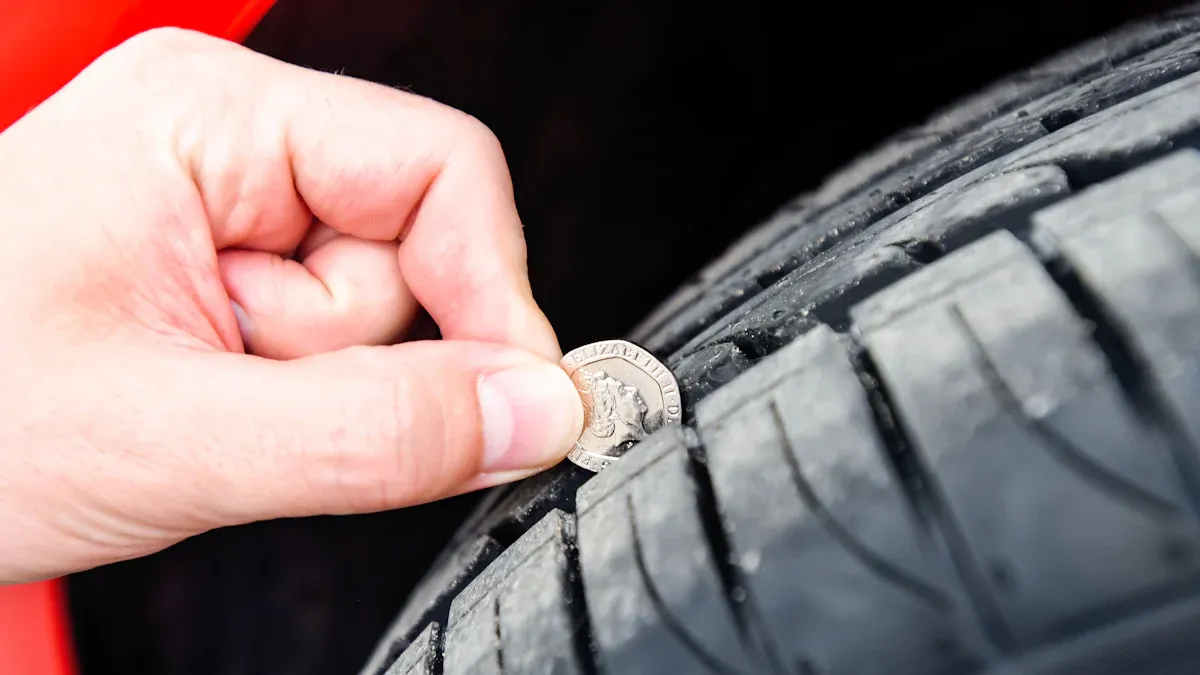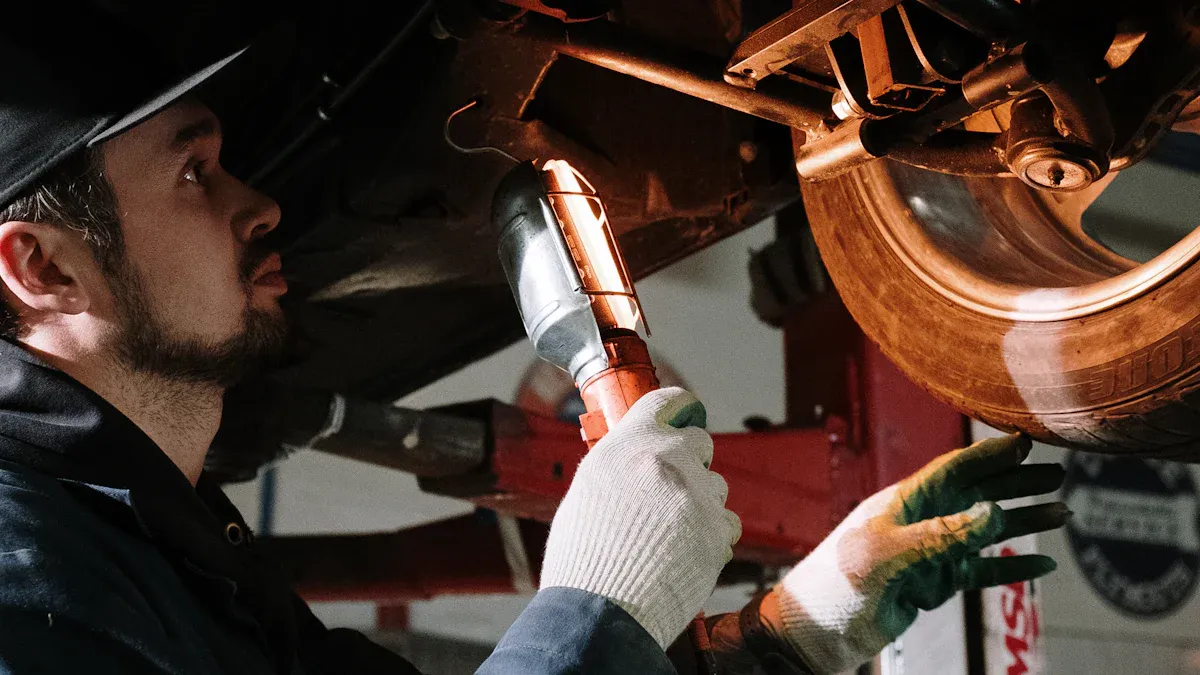
Even a tiny change in tread variance can cause steering wheel shakes. When you drive, your tires are very important for how your car acts. A difference of only 0.1 mm in tread depth can mess up balance and alignment. This can create vibrations that affect your comfort and control. Knowing about this problem is important for your car’s safety and performance.
Key Takeaways
A difference of only 0.1 mm in tire tread depth can make your steering wheel shake a lot. Check your tire tread often to stay safe.
Tire balance and alignment are very important for a smooth ride. Balance your tires every 3,000 to 6,000 miles to stop vibrations.
Watch for signs of shaking, like movement in the steering wheel or seats. Fix these problems early to avoid expensive repairs.
Regularly rotating your tires helps keep the tread even. This makes your vehicle handle better and makes the tires last longer.
Professional checks can find tread differences and their effects. Use special tools for accurate checks and timely care.
Tread Variance Overview

Tread variance means the difference in tread depth on a tire. Even a tiny change, like 0.1 mm, can greatly affect how your vehicle works. Knowing about tread variance is important for safety and good handling on the road.
Tread depth is very important for how your vehicle drives. It affects grip, stopping, and overall steadiness. When the tread depth is not the same, it can cause uneven wear on your tires. This unevenness can make your vehicle drive badly, especially when it’s wet. Here are some important points about how tread depth affects vehicle performance:
Key Finding | Description |
|---|---|
Influence on Braking Performance | Tire tread depth greatly impacts how well vehicles stop, so regular checks are needed for safety. |
Role of Tread Grooves | Tread grooves help create friction and remove water, which is key to avoiding slipping. |
Safety Threshold | If tread depth is less than 1.6 mm, you need to replace the tires to stay safe. |
You should check your tires often to avoid problems with tread variance. Here are some tips to follow:
Drive the Vehicle: Make sure to drive at least 5 miles (8 km) at a high speed (at least 55 mph) to spread the sealant inside your tires.
Identify the Source: Find out if the vibration comes from the front wheels (steering wheel shakes) or the back wheels (body shakes).
Remove Wheel Weights: Take off the wheel weights from both tires on the axle where you feel the shakes.
Add More Ride-On: Put in more Ride-On to reach the right amount.
Test Drive: Drive the vehicle again at highway speeds to check if the shaking has stopped.
By learning about tread variance and its effects, you can take steps to keep your vehicle safe and performing well.
Mechanics of Steering Wheel Vibration

When you drive, how your vehicle moves is very important. Even a small change in tread depth, like 0.1 mm, can really affect this movement. Here’s how:
Vehicle Dynamics | Description |
|---|---|
Changes in the force on the tire as it spins, which affects how comfortable the ride is. | |
Lateral Force Variation | Changes in side forces while the tire spins, which can make the steering pull to one side. |
Conicity | When the tire pulls to one side because of uneven wear or problems from making it. |
Ply Steer | Changes in how the steering feels because of how the tire layers are built. |
Radial Run-Out | When the tire is not perfectly round, which makes the ride less smooth. |
Lateral Run-Out | When the tire’s shape is not right, which affects how the vehicle handles. |
Tread variance throws off the balance and spinning of your tires. This happens when the weight around the tire is not even. One side of the tire can end up heavier. This weight difference creates side forces that make your steering wheel shake back and forth, causing noticeable vibrations.
You will feel these vibrations more at higher speeds, usually between 45 to 70 mph. At these speeds, the shaking is stronger. You might also feel vibrations in the floor or seats, showing how bad the imbalance is.
If you ignore tread variance, it can cause bigger problems later. Over time, it can wear out important parts like ball joints and tie rod ends. This wear can change the toe angle, making it unstable when you turn at high speeds. Too much positive toe can wear tires unevenly, while not enough toe can also cause strange wear patterns. Both situations mean misalignment and possible suspension issues.
Symptoms of Vibration
Feeling your steering wheel shake can be uncomfortable. It’s important to notice the signs early. This way, you can fix the problem before it gets worse. Here are some common signs that show you might have an issue:
Shaking felt in the floor and seats
Worse vibrations at higher speeds
Strange noises or thumping sounds
The car pulling to one side
At first, you might feel a small shake in the steering wheel. Over time, this shake can get stronger. You will probably notice strong vibrations when driving between 50 and 70 mph.
If you see any of these signs, it’s important to find out why. Here’s a table to help you understand different causes of vibration:
Cause of Vibration | Symptoms/Indicators | Solution/Action Required |
|---|---|---|
Unbalanced tires | Vibration felt at higher speeds, getting worse with speed | Perform a wheel balance |
Wheel misalignment | Car pulls to one side, uneven tire wear, steering wheel not centered | Perform a wheel alignment |
Damaged wheel bearings | Vibration when turning, possible grinding noise | Inspect and replace wheel bearings |
Worn steering/suspension parts | Loose or worn parts causing shaking and instability | Inspect and replace damaged parts |
Uneven tire wear | Vibration because tires don’t touch the road evenly | Regular tire rotation and check inflation |
Improper tire inflation | Vibration from tires not touching the road evenly | Check tire pressure and inflate as needed |
If the vibrations don’t go away, it’s time to get help. Keep these points in mind:
If the steering wheel shakes, check tire balance and tread depth.
Look for problems with parts like suspension or bearings.
Get professional help if the issue continues or if you see more signs.
Fixing these problems early can save you from bigger repairs later. Remember, wheel alignment usually costs between $50 and $300. Other repairs can add to the total cost, so it’s smart to budget for checks.
Causes of Tread Variance
Tire Imbalance
Tire imbalance happens when the weight around the tire is not even. This can cause vibrations that you feel in the steering wheel, seat, or floor. Here are some important points about how tire imbalance affects tread variance:
If tires or wheels are not mounted right, they can wear unevenly.
You might see both smooth and bumpy spots on the tire.
In bad cases, you may need to retread or replace the tire.
When you drive fast, vibrations from unbalanced tires are easier to feel. These vibrations can get stronger as you go faster. Fixing tire imbalance with proper balancing helps keep your ride smooth. Using things like Counteract Balancing Beads can also help keep your tires balanced.
Misalignment Issues
Misalignment can make the effects of tread variance worse for how your vehicle handles. If your wheels are not lined up right, you may notice some problems:
Your vehicle might pull to one side, making it hard to steer straight.
Steering response and stability can get worse, which is important for safe driving.
Bad alignment often causes uneven tire wear, making handling harder.
Common misalignment issues include camber wear, heel/toe wear, and feathering. These can happen from hitting potholes, curbs, or from worn-out suspension parts. If you see uneven tread wear, it’s important to check your alignment. Regular maintenance can stop these problems and help your vehicle handle better.
By knowing how tire imbalance and misalignment affect tread variance, you can take steps to keep your vehicle safe and performing well.
Solutions for Diagnosis
Maintenance Practices
Regular maintenance is very important to stop tread variance and the steering wheel vibrations that come with it. Here are some key practices you should do:
Tire Balancing: Balance your tires every 3,000 to 6,000 miles or at least once every 1 to 2 years. This helps fix any weight problems that can cause vibrations.
Wheel Alignment: Make sure your wheels are straight up and down and parallel to each other. If they are not aligned, it can make tread variance worse and affect how your car handles.
Tire Rotations: Rotate your tires often to help them wear evenly. This practice keeps balance and symmetry, which improves how stable and easy to handle your vehicle is.
Tread Depth Checks: Check your tire tread depth at least once a month. This helps you find early signs of variance and makes sure your tires are safe for driving.
By doing these practices, you can keep your tires strong and improve your vehicle’s safety. Regular checks can help you notice problems early, like vibrations in the steering wheel or uneven tire wear.
Professional Inspection
Professional inspections are very important for finding tread variance and its effects on steering wheel vibrations. Trained experts use special tools to find problems correctly. Here are some key points about why professional inspections matter:
Advanced Diagnostic Tools: Professionals often use tools like the iVA Intelligent Vibration Analyzer. This tool uses Quad Vibration Technology™ to find where vibrations come from. It shows how serious the vibrations are, making it easier to find issues related to tread variance.
Regular Inspections: Tire problems, including tread variance, can cause steering wheel vibrations. Even small imbalances can get worse when you drive faster. So, it’s very important to have your tires balanced and inflated correctly.
Industry Best Practices: Check your tire treads every month or before long trips to make sure they are in good shape. This proactive approach can help prevent bigger problems later.
By focusing on both maintenance practices and professional inspections, you can keep your vehicle safe and lower the chances of steering wheel vibrations caused by tread variance.
Taking care of your tires is very important for your car’s safety and how well it works. Fixing tread variance can help stop steering wheel vibrations. Here are some good things about keeping your tires maintained:
Benefit | Description |
|---|---|
Even Weight Distribution | Stops strong vibrations that can make handling and comfort worse. |
Enhanced Steering Response | Makes your car easier to handle and cuts down on steering wheel vibrations. |
Reduced Uneven Tread Wear | Regular balancing helps avoid uneven wear, which causes vibrations. |
Extended Tire Lifespan | Taking care of your tires can make them last longer and keep your car stable. |
By keeping your tires in great condition, you will have a smoother ride and safer driving. Don’t forget to check and maintain them regularly. Your car will appreciate it! 🚗✨
FAQ
What is tread variance?
Tread variance is the difference in tread depth on a tire. Even a tiny change, like 0.1 mm, can affect how well your vehicle works and its safety.
How does tread depth affect my car’s handling?
Tread depth is important for grip, stopping, and stability. If the tread is uneven, it can make handling worse, especially when it’s wet. This increases the chance of accidents.
When should I check my tire tread depth?
You should check your tire tread depth at least once a month. Regular checks help you find problems early and keep driving safe.
What are the signs of tire imbalance?
Signs of tire imbalance include vibrations in the steering wheel, shaking in the seats, and uneven wear on the tires. Fix these problems quickly to avoid more damage.
How can I prevent steering wheel vibrations?
You can stop vibrations by keeping your tires balanced, making sure the wheels are aligned, and checking tire pressure and tread depth often. Regular maintenance is very important! 🚗✨
See Also
Utilizing a Tire Tread Depth Gauge for Precise Measurements
The Importance of Monitoring Tire Tread Depth for Safety
Understanding Smart Tire Tread Depth Detectors and Their Function






